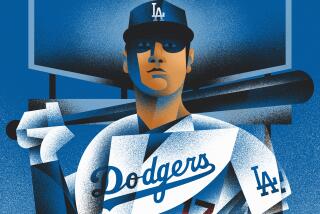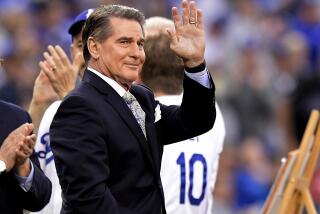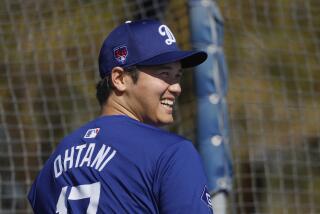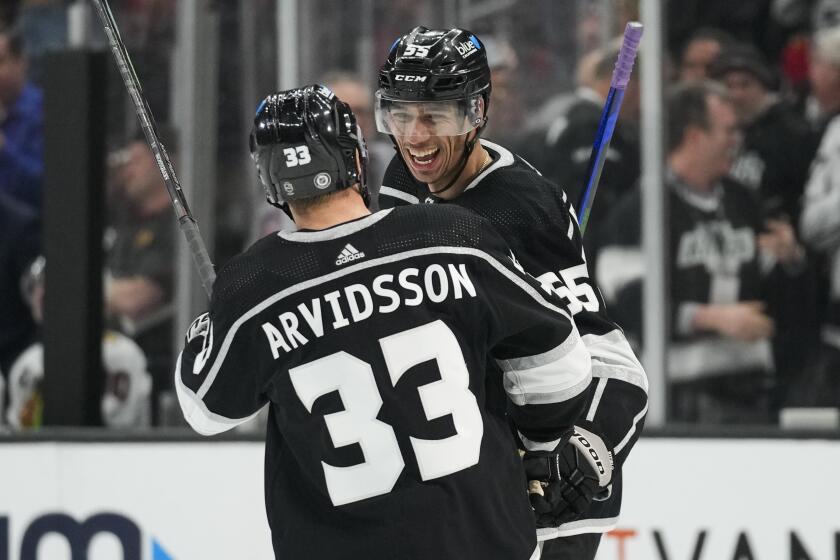Tommy John surgery is becoming just part of the game

It is not unusual for a kid to decide he has no interest in going into the family business. It is a bit different for Lucas Giolito, who turned his back on Hollywood and still might come out ahead in the departments of fame and fortune.
His grandfather, Warren Frost, appeared on “Seinfeld.”
“It’s hard for me to say this,” said Giolito, 20. “I’ve never watched ‘Seinfeld.’”
His uncle, Mark Frost, co-created “Twin Peaks.” His father, Rick Giolito, produced the classic soap opera “As The World Turns” and the classic video game “Medal of Honor.” His mother, Lindsay Frost, has appeared in television shows from “Hill Street Blues” and “L.A. Law” to “Lost” and “Crossing Jordan.”
“She was in a bad science fiction movie in the early ‘90s,” Giolito said. “I actually watched that movie so I could laugh at her.”
The family banter is all in good fun, until Giolito starts talking about how his mother would come home frustrated from auditions, time and time again. No matter how well you performed, your day could be ruined and your career derailed on someone else’s whim.
Baseball can be like that, but not nearly as much. Put up the numbers, and opportunity almost always follows. Giolito had his heart set on baseball, even if his mother had not been so adamant about steering him away from acting.
“I think it’s still more fun to go outside,” he said, “and play a sport for money.”
He is one of the lucky ones.
In 2012, Giolito was hitting 100 mph at Studio City Harvard-Westlake High, projected as the possible first overall pick in the draft. Then his elbow gave out, Tommy John surgery loomed — and the Washington Nationals still took him in the first round and signed him for $2.925 million.
The Nationals had the 16th pick. The Dodgers had the 18th pick, and they had considered taking Giolito if the Nationals had not.
“We would have certainly entertained it, for sure,” said Logan White, the Dodgers’ vice president of amateur scouting.
The Angels drafted the late Nick Adenhart after Tommy John surgery. The Dodgers did the same with Nathan Eovaldi, the key prospect traded to the Miami Marlins for Hanley Ramirez.
“When the success rate is so high, it’s probably worth the risk,” White said.
“Sad to say,” Giolito said, “but it’s become a routine deal for pitchers.”
Giolito pitched in the Futures Game last week, pumping 97 mph fastballs one year after he returned from surgery.
“This is part of baseball now,” he said. “They’re going to get fixed. They’re going to be fine. It’s nothing to be scared of.”
That is the general understanding of Tommy John surgery. But, in this year of the Tommy John epidemic, Giolito’s experience offers a case study in what we know and what we do not.
Stan Conte, the Dodgers’ vice president of medical services, said studies show three in four pitchers return from Tommy John surgery at least as effective as they were before the procedure.
“People think Tommy John surgery is 90-95% successful. That’s not true,” Conte said.
And even those studies, Conte said, track pitchers who had the operation in the major leagues, not in high school.
Giolito returned 11 months after surgery. Conte, speaking generally because he has not worked with Giolito or the Nationals, said the perception is that pitchers usually return after 12 months and the reality is closer to 17 months.
In addition, Conte said, there appears to be an increased risk of the new ligament rupturing for the first two to three years after the pitcher returns.
Giolito said he expects to be limited to about 100 innings this year, in his first full minor league season after surgery, and said he has yet to resume throwing a two-seam fastball. He said the Nationals are guiding him through rehabilitation and return much as they did with Stephen Strasburg and Jordan Zimmermann.
“They’re on top of that stuff,” Giolito said.
The Nationals’ guidelines for increasing innings after surgery appear logical, but the careers of Strasburg and Giolito might need to play out before the industry agrees on a protocol for how many innings a pitcher should work as he recovers from the procedure.
“Most of the stuff with Tommy John surgery is more confusing than it ever has been,” Conte said.
That includes the most fundamental questions of all: Why are all these elbows blowing out, and what might be done to reduce all these injuries?
Dr. James Andrews, the foremost sports orthopedist in America, recently released a position paper citing “a strong link between too much competitive pitching [as a youngster] and arm injuries.”
Said Giolito: “There are 10-year-old travel ball kids playing hundreds and thousands of innings a year of nonstop baseball. I don’t think that’s good.”
Giolito said he did not pitch much until 14 or 15 because he could not throw strikes. In his case, then, overuse could not be blamed for the injury.
“It was a brutal combination of me throwing too hard,” he said, “and my body not being developed enough.”
If not for that injury, Giolito might have been the first player taken in that 2012 draft. As it turned out, he was not even the first player taken from his high school. His Harvard-Westlake teammate, Max Fried, went to the San Diego Padres at No. 7.
Fried made his first appearance of the minor league season this month, after sitting out three months because of what the Padres called forearm soreness. He and Giolito each is at the Class-A level.
“It’s definitely going to be a cool day,” Giolito said, “when we’re facing off against each other in the majors.”
Knock on wood.
More to Read
Get our high school sports newsletter
Prep Rally is devoted to the SoCal high school sports experience, bringing you scores, stories and a behind-the-scenes look at what makes prep sports so popular.
You may occasionally receive promotional content from the Los Angeles Times.







